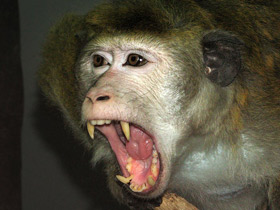The toque macaque (Macaca sinica)
 The toque macaque (Macaca sinica) is included in the IUCN Red List as an "endangered species"
The toque macaque (Macaca sinica) is included in the IUCN Red List as an "endangered species"
The toque macaque (/tɒk məˈkæk/; Macaca sinica) is a reddish-brown-coloured Old World monkey endemic to Sri Lanka, where it is known as the rilewa or rilawa (Sinhala: රිළවා), (hence "rillow" in the Oxford English Dictionary). Its name refers to the whorl of hair at the crown of the head, reminiscent of a brimless toque cap.
Taxonomy
The generic name Macaca is from Portuguese macaco, of unclear origin, while sinica means "of China," even though the species is not found there.
There are three recognized subspecies of toque macaques:
- Macaca sinica sinica, dry zone toque macaque or common toque macaque;
- Macaca sinica aurifrons, wet zone toque macaque or pale-fronted toque macaque;
- Macaca sinica opisthomelas, highland toque macaque or hill zone toque macaque.
Macaca sinica opisthomelas is similar to subsp. aurifrons, but has a long fur and contrasting golden color in the anterior part of its brown cap.
The three subspecies can be identified their head colour patterns.
Habitat
Macaca sinica is a species of catarrhine primate in the family Cercopithecidae. Macaca sinica is endemic to Sri Lanka (formerly Ceylon) and is the smallest member of its genus.
Macaca sinica is a diurnal animal that inhabits both rainforests and montane forests at altitudes of up to 2,200 m. They spend part of the day on the ground. They spend part of the day on the ground and return more frequently to sleep in the trees.
Appearance
Body length about 40 to 55 cm, weight up to 8.4 kg. The coat is brown on top and whitish underneath. The top has two brown or black tufts on the top of the head, pointing outwards and with a hollow in the centre. The naked face is brown and the tail is the same length as the body.
Distribution
Macaca sinica sinica is found from the Vavuniya, Mannar to the lowlands of Anuradhapura, Polonnaruwa, Puttalam, and Kurunegala; and along the arid zone of the Monaragala and Hambantota districts.
Macaca sinica aurifrons can be found sympatrically with the subspecies M. s. sinica within intermediate regions of the country in Kegalle and parts of Kurunegala. It is also found in south-western parts of the island in the Galle and Matara districts near Kalu Ganga.
Macaca sinica opisthomelas has recently been identified as a separate subspecies. It can be found in the entire south-western region of Ratnapura and in the Nuwara Eliya districts. It is also found around Hakgala Botanical Garden and other cold climatic montane forest patches.
Social behaviour
The Macaca sinica lives in groups of 30 to 40 individuals, with twice as many females as males. A strict hierarchy reigns among the males, which is expressed in the foraging and grooming sequence. While females remain in the group in which they are born, males must leave their group when they reach puberty. They sometimes join with other males in all-male groups. They are territorial animals, defending their area of several hundred hectares from other groups.
Reproduction
Unlike other macaque species, female Macaca sinica lack the swelling of the naked buttocks during fertilisation. Within the group, promiscuity reigns, with each male mating with several females and vice versa. After about 160-170 days of gestation, the offspring is born. The parents do not participate in the rearing of the offspring. Weaning takes place after about a year and the offspring reach sexual maturity after 3-6 years.
The life expectancy of the Macaca sinica in the wild is about 20 years.
Particularities and nutrition
These primates feed mainly on fruits, seeds, insects and grasses.
Macaca sinica have to some extent adapted to humans, sometimes raiding plantations and fields. The main threat is deforestation and the resulting loss of living space.
Predators
Wild cats (leopards and fishing cats) and Indian rock python are the main predators of this species.
Conservation
The toque macaque is listed as Endangered by the International Union for the Conservation of Nature (IUCN) due to habitat destruction and hunting, and also for the pet trade. Much of the original forested habitat of the toque macaque has been lost, between 1956 and 1993 50% of Sri Lanka's forest cover was destroyed. Plantations and fuel wood collection have been the main drivers of habitat lost. Toque macaques were also used by both Sri Lanka Army and Tamil Tigers as target practice during the Sri Lankan Civil War. The recent move by the Sri Lankan government to export 100000 monkeys to China has raised opposition from conservationists and zoologist from the island country.
Both subspecies Macaca sinica aurifrons and Macaca sinica sinica are kept as pets.
Antibody prevalence
In an experiment, serum samples taken from toque macaque individuals at Polonnaruwa were examined for antibodies to Toxoplasma gondii by the modified agglutination test. There was no evidence of maternal transmission of antibodies or congenital toxoplasmosis. None of the infected macaques died within 1 year after sampling. Toxoplasma gondii infection was closely linked to human environments where domestic cats were common. Although infection with Toxoplasma gondii has been noted in several species of Asian primates, this is the first report of Toxoplasma gondii antibodies in toque macaques.
















































